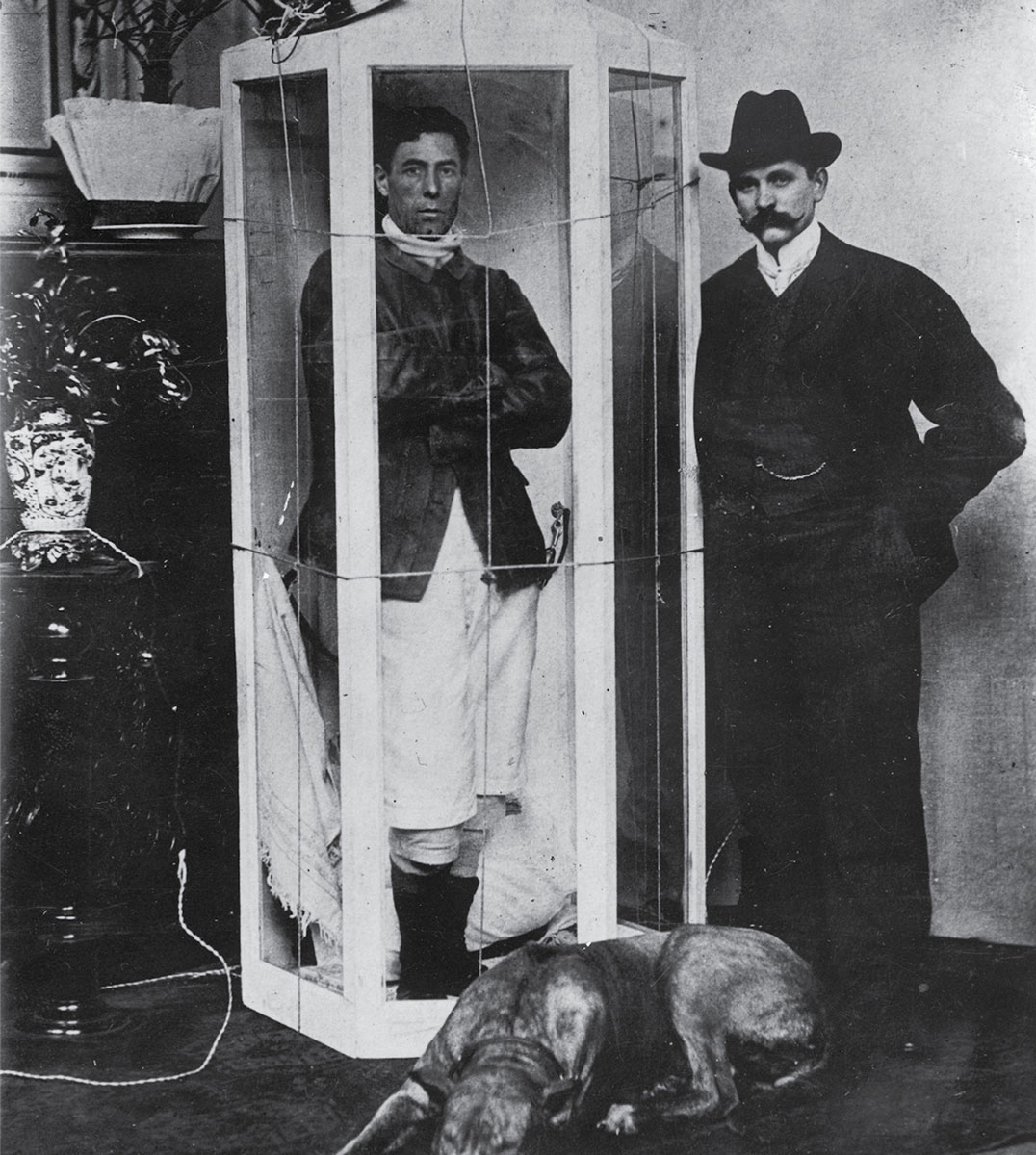Ingestion / The Hunger Artists
Starved for attention
Oliver Preston
“Ingestion” is a column that explores food within a framework informed by aesthetics, history, and philosophy.

A shrunken man, wearing only tights, sits on a bed of straw, in the middle of a cage. A throng of faces encircles the cage. They show mild amusement; they look up at the man for a few minutes before drawing back, satisfied. The children in the crowd stare more earnestly and for longer. A few faces are familiar to the man, though he rarely looks at them. They reappear beside the cage each day and, unlike the others, remain stiff with something—an expectation they themselves seem not to understand. The man is always being watched, if not by the passing spectators then by paid wardens, who are meant to enforce his pledge to live for forty days without food. When the wardens are not on their shifts authenticating the man’s claim, they work in the town, we are told, as butchers.
This is the basic situation of Franz Kafka’s “A Hunger Artist,” a short story first published in a 1922 issue of the Berlin literary magazine Die neue Rundschau and later included in a 1924 collection, which took the story’s name.[1] Like all of Kafka’s stories, “A Hunger Artist” seems to visit us from another world. It is hermetic, to borrow Theodor Adorno’s word. If it is a joke, its punch line is written in Morse code. If it is an allegory, its referents are irretrievable. Adorno offers that, reading Kafka, one might feel overcome by perpetual and unanswerable déjà vu. Apparently agreeing, Walter Benjamin insists that Kafka’s writing belongs to a pre-mythical epoch.[2]
None of which is to say, however, that the figure of the hunger artist hails from the same cosmic no-place as the Odradek.[3] The first sentence of “A Hunger Artist,” “During these last decades the interest in professional fasting has markedly diminished,” might as well have been lifted from a newspaper article.[4] Beginning more or less precisely in 1880, hunger performances surged in popularity across Europe and the United States; by 1930, the fad was in decline. Kafka thus lived and died alongside the hunger artists. In the final years of the nineteenth century, the Italian Giovanni Succi toured Milan, Vienna, London, and New York, fasting for up to forty-five days at a time under the watch of journalists, medical examiners, and paying fans. Beginning in 1906, Clare de Serval, the “Apostle of Hunger” from Berlin, repeatedly shut herself inside a specially made glass box for weeks at a time in an attempt to prove the health benefits of self-starvation, telling one reporter that she was always reluctant to break her fasts.[5] Another Berliner, Siegfried Hertz, faced prosecution when it was discovered that a wire connected to his radio—one of the few furnishings in his fasting box—was in fact a straw through which the performer had been furtively sipping hot chocolate. Kafka likely saw a 1916 report on a hunger artist in the Prager Tagblatt, a newspaper in Prague that he read often. That he himself saw a hunger performance is not entirely out of the question.[6]
Though in one sense it is. Nobody, after all, can see a hunger performance. To witness more than an excerpt would require an endurance outmatching the faster’s. One would have to stay awake while the faster slept, eyes never relinquishing their hold on the body before them, tracking all the countless movements—accidental or gestural, brief or sustained—that make up the material of its slow, staged diminution. “No one could possibly watch the hunger artist continuously, day and night,” Kafka writes, “and so no one could produce first-hand evidence that the fast had really been rigorous and continuous; only the artist himself could know that, he was therefore bound to be the sole completely satisfied spectator of his own fast.”[7]
But then it seems that the appeal of the hunger artist resides only in his authenticity—satisfaction, here, is critical. The spectators face a paradox. In order to determine that the hunger artist is worthy of being watched in the first place, they must commit him to constant, seamless watching. Unless they can resign themselves to faith, in which case they won’t need to lay eyes on the faster, the spectators will watch the act with only its authentication in mind. An attempt to authenticate is also always an attempt to thwart. Those who come closest to witnessing the whole performance—I mean “witness” both in the phenomenological sense of “seeing” and in the legal sense of “legitimating”—will be sustained not by their benign interest but by their doubt. Doubt which they, pricked by rage, continually renew against a backdrop of boredom.
This problem of witnessing—of how to see a hunger performance—especially vexed those medical regimes whose authority the extraordinary claims of fasters threatened. To understand this we must widen the frame of our inquiry. In fact, the hunger artists of Kafka’s day represent just a minor, carnivalesque outcropping of a broad tradition. Self-starvation as spiritual practice has, of course, a history in Europe. For Christian—especially Catholic—mystics, fasting for short spells has long constituted an important expression of piety. Cases of extreme, apparently miraculous abstemiousness among the devout have garnered attention and skepticism at regular intervals since at least the thirteenth century: famously, the saints Angela of Foligno and Catherine of Siena were said to subsist on the Eucharist alone. Young women were involved in most of these cases, and the nineteenth century saw a remarkable proliferation of “fasting girls,” reports of which were appearing by midcentury in newspapers across Britain and the United States.[8]